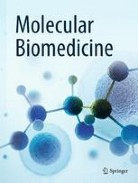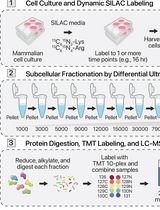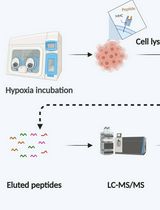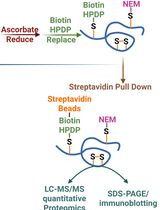- EN - English
- CN - 中文
A mant-GDP Dissociation Assay to Compare the Guanine Nucleotide Binding Preference of Small GTPases
用Mant-GDP分离实验比较小GTP蛋白的鸟嘌呤核苷酸的结合偏好
(*contributed equally to this work) 发布: 2021年01月20日第11卷第2期 DOI: 10.21769/BioProtoc.3886 浏览次数: 4832
评审: Ching Yao YangPiero CrespoAnonymous reviewer(s)
Abstract
Small GTPases are cellular switches that are switched on when bound to GTP and switched off when bound to GDP. Different small GTPase proteins or those with mutations may bind to GTP or GDP with different relative affinities. However, small GTPases generally have very high affinities for guanine nucleotides, rendering it difficult to compare the relative binding affinities for GTP and GDP. Here we developed a method for comparing the relative binding strength of a protein to GTP and GDP using a mant-GDP dissociation assay, whereby the abilities of GTP and GDP to induce the dissociation of bound mant-GDP are compared. This equilibrium type assay is simple, economic, and much faster than obtaining each protein’s affinity for GDP and GTP. The GDP/GTP preference value obtained is useful for comparing the relative GTP/GDP binding preferences of different GTPases or different mutants, even though it is not the real GDP/GTP affinity ratio (but rather an estimation of the ratio).
Keywords: GTPase (GTP酶)Background
Small GTPases (also known as small G proteins) are a group of functionally important macromolecules that can bind to GTP and hydrolyze it into GDP owing to their intrinsic hydrolase activity. In human, more than a hundred different small GTPases are grouped into five families, namely Ras, Rho, Ran, Rab, and Arf, based on their sequence, structure, and function (Wennerberg et al., 2005).
GTPase proteins are cellular switches that are active when bound to GTP and inactive when bound to GDP (Cherfils and Zeghouf, 2013). Generally, small GTPases have very high affinities towards guanine nucleotides (GDP and GTP) (Bos et al., 2007). To switch on/off precisely, two groups of proteins are often required, namely, the GTPase activating proteins (GAPs), which activate the hydrolase activity (to switch off the GTPase), and guanine nucleotide exchange factors (GEFs), which lower nucleotide affinity to allow exchange of nucleotides (usually switching the GTPase on).
The affinity towards GTP or GDP can vary between wild type and mutant proteins (John et al., 1993; Klebe et al., 1995). Because the affinities for GTP and GDP are high, in the pico- to nano- molar range, they are usually hard to measure directly, and are instead measured separately by determining the association rate constant kon and the dissociation rate constant koff (Goody et al., 1992; Ahmadian et al., 2002). One way to measure koff is to first charge a protein with fluorescently labeled nucleotides, then incubate the protein in an excess of free nucleotide to measure the dissociation rate of fluorescently labeled nucleotides (John et al., 1993; Klebe et al., 1993 and 1995). Usually a stop-flow device is needed to measure kon, whereby different concentrations of apo protein (lacking GDP or GTP) are rapidly mixed with fluorescently labeled nucleotides (John et al., 1990; Ahmadian et al., 2002). For the Ras-related nuclear protein Ran, kon is not measureable because of the difficulty in generating apo Ran (Klebe et al., 1995).
Mant (N-methylanthraniloyl)-GDP and mant-GTP are the most widely used fluorescently labeled nucleotides because they have the following two characteristics (Hiratsuka, 1983; Ahmadian et al., 2002). First, modification of the mant group usually does not alter the interaction of GDP/GTP with the protein (John et al., 1990). Second, mant fluorescence increases by about two-fold after binding to proteins, and the fluorescence of bound mant is often sensitive to environmental changes such as binding of other proteins (Alexandrov et al., 2001; Kanie and Jackson, 2018). In addition to fluorescent labeling methods, filter binding (radioactive labeling) and intrinsic tryptophan fluorescent changes can also be used to measure association/dissociation rates; however, their usage is more limited (Feuerstein et al., 1987; Klebe et al., 1993; Kanie and Jackson, 2018).
Measuring kon and koff separately can be time consuming and laborious. Generating mant-nucleotide-labeled proteins or using an excess of mant-nucleotides to dissociate the bound nucleotide often requires a large amount of mant-nucleotides, which are expensive. Here we present a quick, simple, and economic mant-GDP dissociation assay to estimate the relative GTP/GDP binding affinities or the ‘GTP preference’ of small GTPases. We tested this assay using the small GTPase Ran and one of its mutants RanP180L, which was once reported in the cancer database cBioPortal (https://www.cbioportal.org/). P180 is located at the C-terminal autoinhibitory tail of Ran, and mutation of this residue might affect GTP/GDP preference. The method we developed for estimating ‘GTP preference’ is reproducible and yields results that agree well with those in the literature, as illustrated by the examples provided.
Materials and Reagents
Micro-centrifuge tube (Biosharp, Life sciences, catalog number: BS-15-M )
50 ml centrifuge tube (Biofil®, catalog number: CFT011500 )
15 ml centrifuge tube (Biofil®, catalog number: CFT011150 )
Petri dish (Biofil®, 90 mm Petri dish)
Centrifugal filter (Vivaspin® Turbo 15, 10,000 MWCO PES )
Chromatography column (Sangon Biotech®, catalog number: F506609-0001 )
HiTrap Q HP 5ml(GE Healthcare,catalog number: 17115401 )
Aluminum foil (METRO)
96-well microplate (Sangon Biotech, catalog number: F605033-0001 )
Multichannel pipette tip (Biofil®)
Oak ridge PPCO centrifuge tube (Thermo ScientificTM NalgeneTM, catalog number: 3119-0010PK )
BL21 (Genotype: F-, ompT, hsds (Rbb-Mb-), gal, dcm (DE3))
Plasmids encoding recombinant GTPase with 6x his-tag (Synthesized from TsingKe Biological Technology)
2-mercaptoethanol (BME) (Amresco®, catalog number: 0482-250ML )
Agar (Sangon Biotech, catalog number: A505255-0250 )
Guanosine 5'-triphosphate trisodium salt (GTP·Na3) (Sangon Biotech, catalog number: A620250-0100 )
Guanosine 5'-diphosphate disodium salt (GDP·Na2) (Sangon Biotech, catalog number: A600492-0100 )
Classical laemmli sodium dodecyl sulfate-polyacrylamide gel electrophoresis (SDS-PAGE) gel preparation kit (Sangon Biotech, catalog number: C631100-0200 )
Unstained protein marker (Sangon Biotech, catalog number: C600524-0020 )
Coomassie Brilliant Blue R-250 (Sangon Biotech, catalog number: A100472-0025 )
Ni-NTA Sefinose (TM) Resin (Sangon Biotech, catalog number: C600033-0100 )
Milli-Q water
Phenylmethylsulfonyl fluoride (PMSF) (Sangon Biotech, catalog number: A610425-0025 )
Glycerol (Chengdu Kelong Chemical Reagent Factory)
Glycine (Sangon Biotech, catalog number: A100167-0001 )
Mant-GDP triethylammonium salt solution (Jena Bioscience, catalog number: NU-204S ) (chemical structure was shown in Figure S1)
Tris (Sangon Biotech, catalog number: A100193-0005 )
SDS (Beyotime, catalog number: ST626 )
Concentrated HCl (Chengdu Kelong Chemical Reagent Factory)
Glacial acetic acid (Chengdu Kelong Chemical Reagent Factory)
Ethanol (Chengdu Kelong Chemical Reagent Factory)
HEPES (Sigma-Aldrich, catalog number: V900477-500G )
Sodium hydroxide (Chengdu Kelong Chemical Reagent Factory)
Sodium chloride (NaCl) (Sangon Biotech, catalog number: A610476-0001 )
Tryptone (Sangon Biotech, catalog number: A110859-0500 )
Yeast extract (OXOID, catalog number: LP0021 )
Liquid nitrogen
Magnesium chloride hexahydrate (MgCl2·6H2O)
Ethylenediaminetetraacetic acid disodium salt dihydrate (EDTA) (Chengdu Kelong Chemical Reagent Factory)
IPTG (Sangon Biotech, catalog number: A100487-0100 )
Isopropanol (Chengdu Kelong Chemical Reagent Factory)
Ampicillin (Sangon Biotech, catalog number: A610028-0025 )
LB broth (see Recipes)
LB agar plate containing 100 μg/ml ampicillin (see Recipes)
100 mg/ml ampicillin (see Recipes)
1 M IPTG (see Recipes)
1 M Tris-HCl (pH 7.5) (see Recipes)
1 M HEPES-NaOH (pH 7.5) (see Recipes)
5 M NaCl (see Recipes)
100x PMSF (see Recipes)
50% glycerol (see Recipes)
1 M MgCl2 (see Recipes)
2 M imidazole-HCl (pH 7.5) (see Recipes)
0.5 M EDTA (pH 8) (see Recipes)
10 M NaOH (see Recipes)
10x running buffer (see Recipes)
5x loading buffer (see Recipes)
Coomassie Brilliant Blue staining solution (see Recipes)
Coomassie Brilliant Blue destaining solution (see Recipes)
Lysis buffer (see Recipes)
Wash buffer (see Recipes)
Elution buffer (see Recipes)
Stock buffer (see Recipes)
Mant-GDP exchange buffer (see Recipes)
Equipment
Milli-Q water (Elix® Advantage Water Purification System)
250 ml culture flask (Chengdu Shuniu, catalog number: sjsp24624 )
2 L culture flask (Chengdu Shuniu, catalog number: sjsp4637 )
500 ml beaker (Chengdu Shuniu, catalog number: sb56448 )
Incubator shaker (Shanghai Zhichu Instrument Co., Ltd, model: ZQZY-80CH )
Low-speed and high-capacity refrigerated centrifuge (Wuxi Ruijiang Analysis Instrument Co., LTD, model: RJ-LD-5000C )
Refrigerated centrifuge (SCILOGEX, model: SNJK-D3024R )
1 L centrifuge bottle (Thermo ScientificTM NalgeneTM PPCO, catalog number: DS3132-0063 )
Benchtop pH meter (Ohaus®, model: STARTER 2100 )
AKTA Pure Chromatography System (GE Healthcare, model: AKTA Pure )
-80 °C freezer (Haier, model: DW-86L626 )
Refrigerated centrifuge (Beckman Coulter, model: Avanti J-26S XP , catalog number: B14536)
Fluorescent microplate reader (BioTek, model: SynergyTM H1 )
Sonifier (BioSafer, model: 650-92 )
360° vertical rotator (SCILOGEX, model: MX-RL-E )
Lab stand (Chengdu Shuniu, catalog number: a13104 )
Electrophoresis tank (Bio-Rad Mini-PROTEAN® Tetra, model: 1658000 )
4 °C and -20 °C refrigerator (Haier, model: BCD-571WDPF )
Vortex mixer (Crystal Technology & Industries, Inc., ScilentShake®, model: VM-01U, serial number: 3222046)
Multichannel electronic pipette (Dragonmed toppette)
Autoclave (Zealway, model: GR85DA )
Mental bath (SCILOGEX, model: HB120-S )
NanoPhotometer (IMPLEN, model: IMN50/N60 )
SuperdexTM 200 Increase 10/300 GL Prepacked TricornTM Columns (GE Healthcare)
Software
Microsoft Excel (Microsoft)
GraphPad Prism 7 software (GraphPad Software)
Procedure
文章信息
版权信息
© 2021 The Authors; exclusive licensee Bio-protocol LLC.
如何引用
Tan, Y. and Sun, Q. (2021). A mant-GDP Dissociation Assay to Compare the Guanine Nucleotide Binding Preference of Small GTPases. Bio-protocol 11(2): e3886. DOI: 10.21769/BioProtoc.3886.
分类
生物化学 > 蛋白质 > 定量
癌症生物学 > 癌症生物化学 > 蛋白质
您对这篇实验方法有问题吗?
在此处发布您的问题,我们将邀请本文作者来回答。同时,我们会将您的问题发布到Bio-protocol Exchange,以便寻求社区成员的帮助。
提问指南
+ 问题描述
写下详细的问题描述,包括所有有助于他人回答您问题的信息(例如实验过程、条件和相关图像等)。
Share
Bluesky
X
Copy link













